Lorsch Illuminations in the Wake of the Master of the Registrum Gregorii
- Early Lorsch Initials in the Ottonian Era
- Miniatures and Initials in the Oudalricus-Peccator-Manuscripts
After the downfall of the Lorsch scriptorium in the late Carolingian age, the scribal activities in the Abbey gradually recovered since the end of the 10th century. This also involved the revival of Lorsch illumination. The latter seems to have been initiated by the so-called Master of the Registrum Gregorii, who at the time of Archbishop Egbert (977-993) worked in Trier, amongst others, on an illustrated sacramentary (Chantilly, Bibliothèque du château, Ms. 40/1447), very probably intended for Lorsch. The forms of this manuscript and others, which the Master of the Registrum Gregorii had worked on, brought Lorsch’s initial ornamentation and the painting of miniatures up to renewed heights.
Early Lorsch Initials in the Ottonian Era
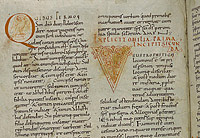 A group of red initials appeared for the first time at the end of the 10th century under Abbot Saleman (972-999) and can be detected up until the 11th century. A commentary on Ezekiel by Gregory the Great (Vatican, BAV, Pal. lat. 253, fol. 4v), written at the end of the 10th century in Lorsch, contains two initials: in the left column an eagle with wings and a nimbus (or halo), the symbol of John the evangelist, placed in the inner circle of the letter Q, and in the right column the initial V with scroll ornaments. These scroll ornaments in the triangular spandrel of the V are symmetrically arranged around a stem and end in four quatrefoils. At the top left they have been woven through the gap in the body of the letter, and on the right-hand side they wind themselves around it. Similar initials with scrolled ornaments can also be found in an addition of a gospel lesson from around 1000 (BAV, Pal. lat. 494, fol. 6r), an evangelistary (Munich, BSB, Clm 23251, foll. 24r, 28r), and a book of gospels (Stuttgart, WLB, Cod. bibl. 2° 44, fol. 11r) from the first quarter of the 11th century. The Stuttgart gospel book moreover contains two I-initials: each is formed out of strands of scrolls with bud- and heart-shaped leaves, and one has an animal head in the middle of its stem (foll. 50r, 130v).
A group of red initials appeared for the first time at the end of the 10th century under Abbot Saleman (972-999) and can be detected up until the 11th century. A commentary on Ezekiel by Gregory the Great (Vatican, BAV, Pal. lat. 253, fol. 4v), written at the end of the 10th century in Lorsch, contains two initials: in the left column an eagle with wings and a nimbus (or halo), the symbol of John the evangelist, placed in the inner circle of the letter Q, and in the right column the initial V with scroll ornaments. These scroll ornaments in the triangular spandrel of the V are symmetrically arranged around a stem and end in four quatrefoils. At the top left they have been woven through the gap in the body of the letter, and on the right-hand side they wind themselves around it. Similar initials with scrolled ornaments can also be found in an addition of a gospel lesson from around 1000 (BAV, Pal. lat. 494, fol. 6r), an evangelistary (Munich, BSB, Clm 23251, foll. 24r, 28r), and a book of gospels (Stuttgart, WLB, Cod. bibl. 2° 44, fol. 11r) from the first quarter of the 11th century. The Stuttgart gospel book moreover contains two I-initials: each is formed out of strands of scrolls with bud- and heart-shaped leaves, and one has an animal head in the middle of its stem (foll. 50r, 130v).
Miniatures and Initials in the Oudalricus-Peccator-Manuscripts
Around the mid-11th century elaborate miniatures, which also drew their inspiration from the Master of the Registrum Gregorii, can be found in the manuscripts of the so-called Oudalricus-Peccator-Group. There are five core manuscripts in which a benefactor is noted as Oudalricus, who can be identified as Abbot Udalrich from Lorsch (1056-1075). The five manuscripts are: one gospel book (former  Aschaffenburg, Hofbibl., Ms. 20 [lost]), two evangelistaries (London, British Libr., Harley 2970; Munich, BSB, Clm 23630), a Pseudo Alcuin, De divinis officiis (Munich, UB, 4° Cod. ms. 179) and a Tonarius of Berno from Reichenau (Vatican, BAV, Pal. lat. 1344). The gospel book as well as the two evangelistaries contain portraits of evangelists, which can be traced back to a lost cycle of works from the Master of the Registrum Gregorii. Seven surviving photographs of the gospel book, which was last held in Aschaffenburg and whose whereabouts are unknown, reveal little variation in the depiction of the evangelists posed in the act of writing. The miniatures are dominated by the architectural frame of a building. In the two evangelistaries the buildings have been moved to the upper margin of the picture, into the background. If you compare the London with the Munich cycle, you can recognize immediately the agreement in every detail of composition and execution. Still, they probably did not originate from the same hand. The London miniatures are dated a little earlier.
Aschaffenburg, Hofbibl., Ms. 20 [lost]), two evangelistaries (London, British Libr., Harley 2970; Munich, BSB, Clm 23630), a Pseudo Alcuin, De divinis officiis (Munich, UB, 4° Cod. ms. 179) and a Tonarius of Berno from Reichenau (Vatican, BAV, Pal. lat. 1344). The gospel book as well as the two evangelistaries contain portraits of evangelists, which can be traced back to a lost cycle of works from the Master of the Registrum Gregorii. Seven surviving photographs of the gospel book, which was last held in Aschaffenburg and whose whereabouts are unknown, reveal little variation in the depiction of the evangelists posed in the act of writing. The miniatures are dominated by the architectural frame of a building. In the two evangelistaries the buildings have been moved to the upper margin of the picture, into the background. If you compare the London with the Munich cycle, you can recognize immediately the agreement in every detail of composition and execution. Still, they probably did not originate from the same hand. The London miniatures are dated a little earlier.
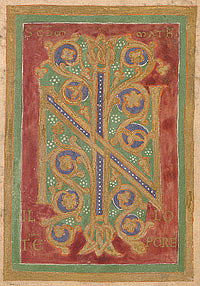 A further fragment of a gospel book from around the same time, which was presumably written in Lorsch (Oxford, Bodl. Libr., Douce Ms. 292), also holds portraits of the evangelists that are reminiscent of the Master of the Registrum Gregorii. Through miniatures, and especially the artful initials of the Oudalricus-Group, which in turn reveal a connection to older initials with scroll ornaments, further manuscripts can be brought into association with this group. The IN-ligature of the decorated initial page of an evangelistary from Vienna (ÖNB, Cod. 1140, fol. 1r) is almost a one-to-one replica of the slightly older Munich Oudalricus-evangelistary (Munich, BSB, Clm 23630, fol. 7v): on a crimson background the N and scrolls growing out of the stem of an I form a frame around a green and blue background. The golden bodies of the initials have a red border, the spaces between are blue with white dots, flower-like white dots are also spread over the green background. The scrolls terminate in trilobes and quadrilobes or other forms of small leaves. In contrast to the Munich manuscript, the scrolls protrude further upwards and downwards, forming an area which is less confined by the N and in which the interlace knots at the ends of the I do not appear to stand out as much. The distribution of blue and green is reversed, and the scrolls and the clasps on the uprights of the N are worked in silver. Moreover, the frame with an ornamented band and golden and silver border lines is far more elaborate.
A further fragment of a gospel book from around the same time, which was presumably written in Lorsch (Oxford, Bodl. Libr., Douce Ms. 292), also holds portraits of the evangelists that are reminiscent of the Master of the Registrum Gregorii. Through miniatures, and especially the artful initials of the Oudalricus-Group, which in turn reveal a connection to older initials with scroll ornaments, further manuscripts can be brought into association with this group. The IN-ligature of the decorated initial page of an evangelistary from Vienna (ÖNB, Cod. 1140, fol. 1r) is almost a one-to-one replica of the slightly older Munich Oudalricus-evangelistary (Munich, BSB, Clm 23630, fol. 7v): on a crimson background the N and scrolls growing out of the stem of an I form a frame around a green and blue background. The golden bodies of the initials have a red border, the spaces between are blue with white dots, flower-like white dots are also spread over the green background. The scrolls terminate in trilobes and quadrilobes or other forms of small leaves. In contrast to the Munich manuscript, the scrolls protrude further upwards and downwards, forming an area which is less confined by the N and in which the interlace knots at the ends of the I do not appear to stand out as much. The distribution of blue and green is reversed, and the scrolls and the clasps on the uprights of the N are worked in silver. Moreover, the frame with an ornamented band and golden and silver border lines is far more elaborate.
Similar initials with scrolls terminating in flowers, fruits, trilobes and other decoration are not only to be found in these two manuscripts (e.g. Munich, BSB, Clm 23630, fol. 39v and Vienna, ÖNB, Cod. 1140, fol. 51r), but also in the older group, and in further manuscripts from the Oudalricus-Peccator-Group with plenty of gold and silver (e.g. Vatican, BAV, Pal. lat. 499, fol. 9v, Princeton, Univ. Libr., Garrett Collection Ms. 43, fol. 5r, and Paris, Bibl. St. Geneviève, Ms. 2657, fol. 47v). According to Hartmut Hoffmann the initials of Lorsch manuscripts from the 11th century show “a line of development and similarities, which can be regarded as characteristic features of a school of illumination” (Hoffmann 1986, p. 225).
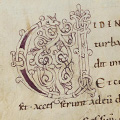
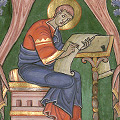
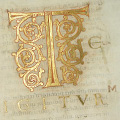
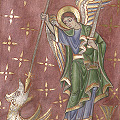
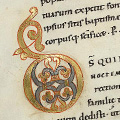

![[de]](/images/all/flag_de.gif)
![[it]](/images/all/flag_it.gif)
